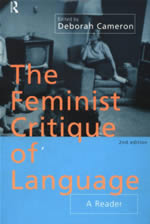
Feminism and Language
There are three main themes about feminism and language that one can focus on in relation to texts:
- The theme of silence and exclusion, which raises issues of authenticity, ways a woman should speak and write.
- The theme of representation, in which one examines the cultural meaning of gender, how it is constructed and contested.
- The theme of how we become gendered through our linguistic behavior.
Deborah Cameron, in her introduction to The Feminist Critique of Language, argues that there are public and private uses of language. The private uses of language are “confined to the space of home, family, and immediate community” (3). These private domains are the types of environments many of Woolf’s heroines grapple to understand in relation to their own identities. How much do these private worlds that women inhibit influence their identities or sense of self-worth? What does women’s emerging role into the public domain, such as the issues about education and a woman’s career, as addressed in A Room of One’s Own (1929), change how women and contemporary societies view women’s issues?
Many of the female characters in Mrs. Dalloway and To the Lighthouse grapple with their identities in terms of private and public domains. Should women be confined to roles such as Mrs. Dalloway and Mrs. Ramsay, hostesses and mothers, and should they be able to rebel against the conventions of the society like Lily Briscoe and dedicate their lives to the pursuit of a career, the pursuit of craft and artwork? Though Virginia Woolf does not provide straightforward answers to any of these questions, she implies that a balance can be achieved, if given the time to grow.
In fact, in her short essay “Women and Fiction,” Virginia Woolf describes the values inherent in the domestic domains of a woman’s life, especially in relation to women’s history. Extraordinary women, like Lily, depend on ordinary women, like Mrs. Ramsay:
It is only when we know what were the conditions of the average woman’s life—the number of her children, whether she had money of her own, if she had a room to herself, whether part of the housework was her task—it is only when we can measure the way of life and the experience of life made possible to the ordinary woman that we can account for the success or failure of the extraordinary woman as a writer. (Feminist Critique 48)
The relationships between women, regardless of whether they are ordinary or extraordinary, highlight the experiences that tell a history. In my analysis of two of Woolf’s novels, the relationships between the women are strengthened by their differences from each other. Woolf highlights the intellectual, thought-provoking minds of different types of people ranging from an old flower-seller to the perfect hostess. These dichotomies, both of age, class, status, gender, all influence the greatness of women’s writings. Though “law and custom were…largely responsible for [the] strange intermissions of silence and speech,” women such as Virginia Woolf are sparking a revelation (48). Silent women need no longer remain silent. Writers, such as Woolf, explore the depths of their minds, probing their thoughts in relation to other characters in the novels, to highlight the deep mysteries that identify an individual. Though silence still pervades the women of their time, even in the novels, the silences themselves speak volumes.
Work Cited
Cameron, Deborah. ed. The Feminist Critique of Language: A Reader. New York: Routledge, 1998.